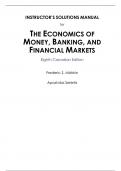Exam (elaborations)
Solutions Manual For The Economics of Money, Banking, and Financial Markets 8th (Canadian Edition) By Frederic Mishkin (All Chapters, 100% original verified, A+ Grade)
- Course
- Institution
Solutions Manual For The Economics of Money, Banking, and Financial Markets 8th (Canadian Edition) By Frederic Mishkin (All Chapters, 100% original verified, A+ Grade) The Economics of Money, Banking, and Financial Markets, 8th Canadian Edition, 8e Frederic Mishkin (Solutions Manual All Chap...
[Show more]



